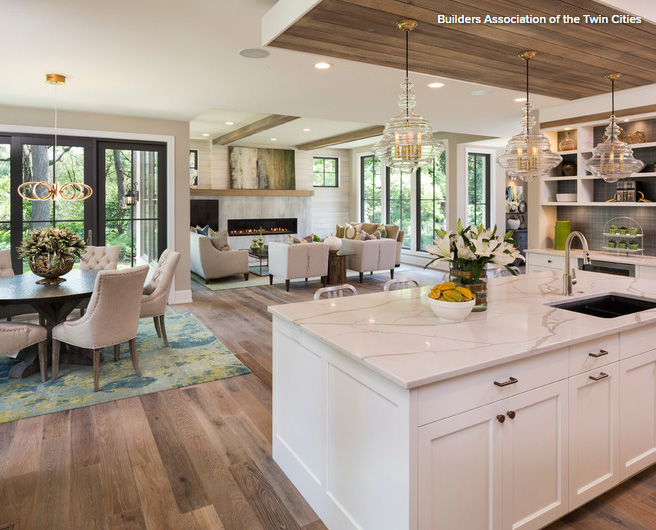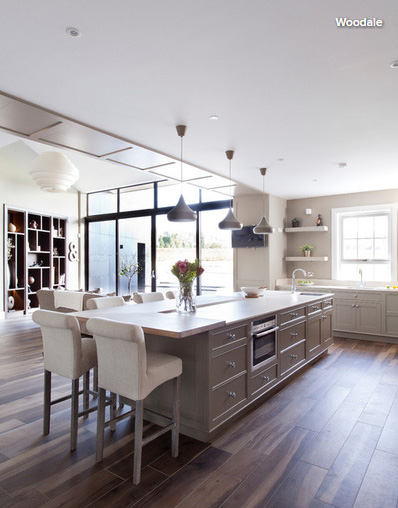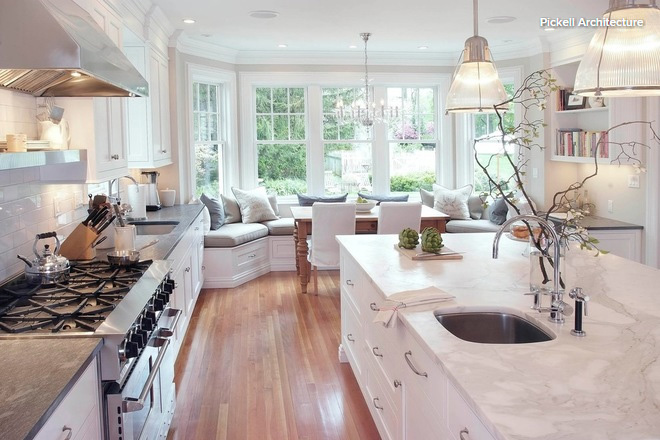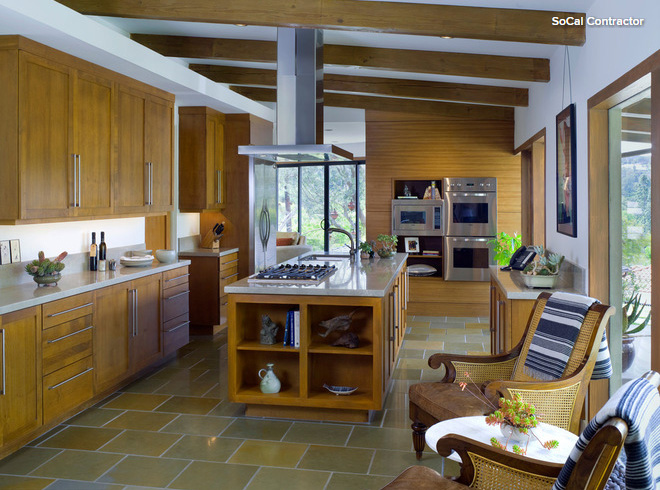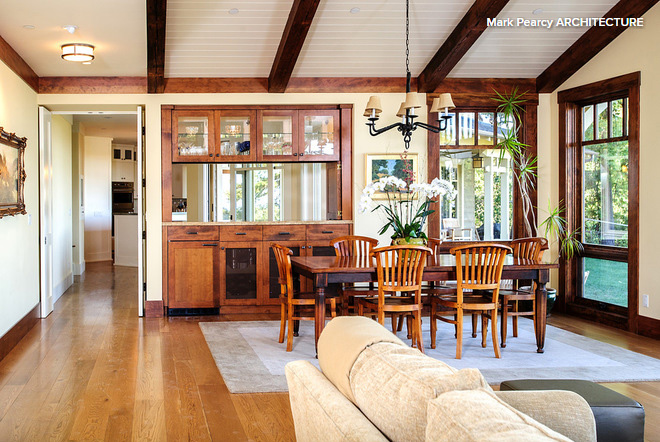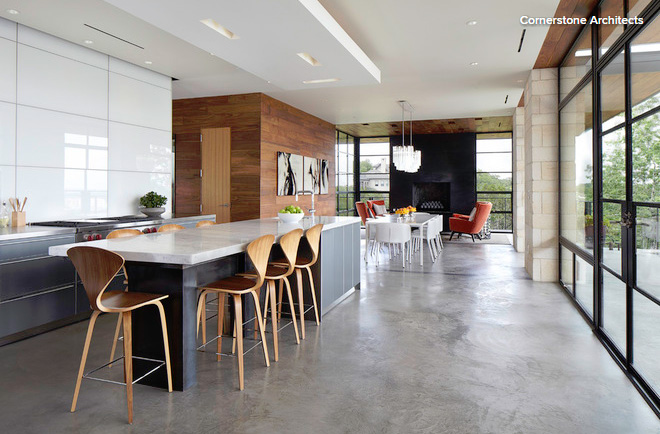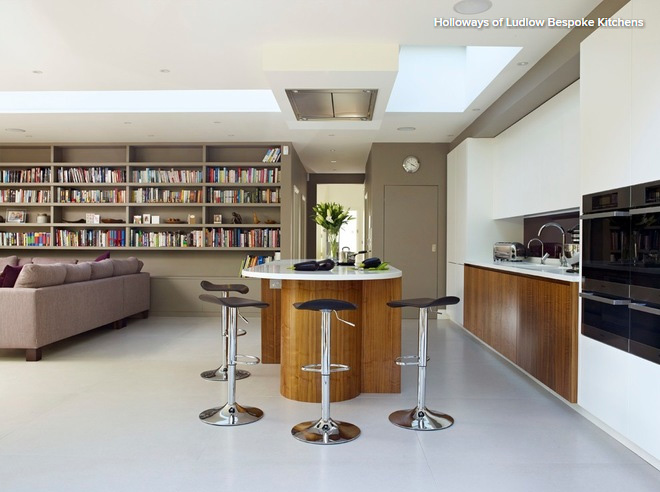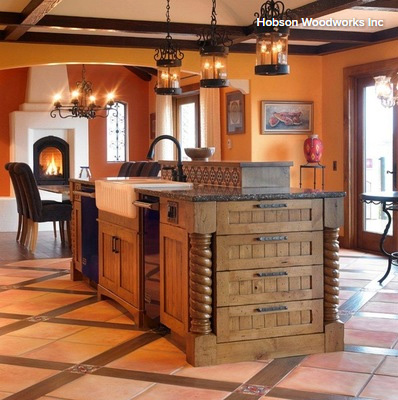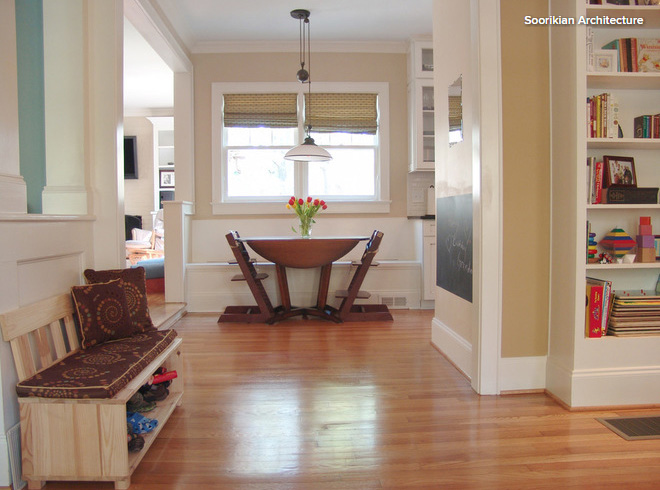Pregunta al experto: 10 trucos para abrir la cocina al resto de la casa
Conoce las estrategias que ayudarán a que el ambiente de la cocina enlace con el resto de forma coherente… y sin barreras.
By Lluisa Deulonder | October 5, 2016
La cocina abierta y comunicada con el comedor o el salón, bien sea con una barra, ocupando un extremo de un espacio común, con un hueco a modo de pasaplatos o en forma de cocina americana, es el gran referente en las reformas que se hacen hoy. Ahora, buscamos espacios abiertos, en los que la cocina se funda con el comedor y el salón y donde cocinar tiene la misma importancia que relajarse, comer y compartir el rato. Son cocinas sin prejuicios, integradas en el hogar, que se reivindican como protagonistas principales. Aquí tienes 10 trucos infalibles para lograrlo.
1. Elige el mismo material y tonos
Una de las ventajas de abrir la cocina al comedor es que se gana en amplitud: el campo de visión no topa con ninguna frontera, integrando zonas que conviven en armonía. Un buen truco para generar esta complicidad es usar un mismo material en el suelo, como aquí el parqué, y una misma gama de colores –en este caso, el blanco de los muebles de la cocina y las butacas y sofás del comedor.
Cocina americana: Ideas para crear ambientes con los revestimientos
2. La isla: una elección clásica que promete espacio y confort
Una fantástica isla de grandes dimensiones es el centro neurálgico de esta cocina abierta a la sala de estar. Rodean la isla unas butacas altas, que prometen confort y buena compañía. Incluso la televisión, colgada de la pared frontal y que puede verse desde la barra de la isla o desde el cómodo sofá, sirve para integrar los espacios. Aquí la cocina abierta da amplitud al espacio y, además, sirve para potenciar la luz natural.
Islas de cocina: Por qué instalar una y cómo aprovecharla al máximo
3. ¿Qué tal un frontal sobrio con muebles bajos?
También hay cocinas sin pretensiones, que se dan la mano con el resto del hogar, como en este caso: un sencillo frontal sin muebles altos, que se codea con el sofá y la mesa comedor con total naturalidad.
4. Los sofás y bancos son para la cocina
Convierte un espacio destinado, en principio, a preparar las comidas, en uno para la convivencia familiar y el diálogo: instala un sofá o banco. Colócalo junto a la ventana, y usa textiles y cojines a tono con el look de la cocina. En la imagen, mármol, madera y cristal, materiales nobles, ensalzan el conjunto, rematado por el verde de los árboles del exterior.
5. y las butacas también
Si acabamos de sugerir colocar un sofá en la cocina, ¿por qué no unas butacas? Fuera complejos. ¿Resultado? Un ambiente distendido que invita a cocinar y a pasar un buen rato. Los tonos cálidos –el verde pantano del suelo; la madera de los muebles–, contribuyen a envolver un espacio resguardado.
Por lo demás, y gracias a una acertada integración, las tradicionales vigas vistas conviven de maravilla con electrodomésticos ultramodernos, empotrados en la pared del fondo.
6. El pasaplatos: una solución cómoda
Una solución imaginativa para establecer una relación de continuidad entre cocina y sala de estar, es instalar un pasaplatos que comunique ambas zonas.
7. Usa lámparas para jugar con el espacio
Usa lámparas y elementos del techo para jugar a la separación-unión de espacios, una solución menos habitual que zonificar cambiando el pavimento.
8. Valora una barra como elemento para definir zonas
Este espacio es un claro ejemplo de cocina que se funde con la sala de estar: una barra separa ambos ambientes sin traumas. Una campana extractora superior de acero inoxidable permite un campo visual limpio. El sofá encuentra su sitio natural a pocos metros de la cocina, que se ofrece como un lateral sobrio y discreto.
9. La chimenea: un elemento sorpresa que unifica ambientes
Aquí la cocina apenas se advierte. La isla central parece un mueble de un castillo, a conjunto con las señoriales lámparas de hierro forjado. Solo el fregadero de mármol, con frontal visto y grifo esmaltado en negro, recuerda que estamos en una cocina. Sin duda, se trata de un espacio muy personal, con la chimenea al fondo, que aporta calidez y que sirve, de manera sorprendente, para unir las distintas áreas.
10. Usa el mismo color en los muebles (preferiblemente blanco) para dar continuidad al espacio
Sala de juegos, el comedor, la sala de estar y, por supuesto, la cocina, comparten aquí un mismo estilo, a base de muebles lacados en blanco, sobrios y modernos. El suelo de parqué recorre todo el piso, que casi parece un loft.
CUÉNTANOS…
¿Eres fan de las cocinas abiertas? Comparte tu opinión en la sección de comentarios
— TRANSLATION —
Ask an expert: 10 tips to open the kitchen to the rest of the house
Know the strategies that will help the kitchen environment link with the rest consistently … and without barriers.
By Lluisa Deulonder | October 5, 2016
Open and connected kitchen with the dining room or living room, either with a bar, holding one end of a common space, with a gap as a serving hatch or as kitchenette, is the great reference in the reforms that are made today. Now, we look for open spaces, where the kitchen is founded with the dining room and lounge and where cooking is just as important to relax, eat and share the time. They are kitchens without prejudice, integrated in the home, which are claimed as the main protagonists. Here are 10 sure-fire tricks to achieve it.
1. Choose the same material and colors
One of the advantages of opening the kitchen to the dining room is the gain in breadth: the field of vision does not run into any borders, integrating areas that coexist in harmony. A good trick to generate this complicity is to use the same material on the ground, as here the floor, and the same range of colors in this case, the target of kitchen furniture sofas and armchairs and dining.
Kitchenette: Ideas to create environments coatings
2. The island: a classic choice that promises comfort and space
Fantastic large island is the hub of the open kitchen to the living room. Around the island a high seats, which promise comfort and good company. Even television, hanging on the front wall and can be seen from the island bar or the comfortable sofa, serves to integrate the spaces. Here the open kitchen gives breadth to space and also serves to enhance the natural light.
Kitchen Islands: Why install one and how to make the most
3. How about a low frontal sober furniture?
There are also kitchens unpretentious to shake hands with the rest of the home, as in this case: a frontal simple without tall furniture, which rubs shoulders with sofa and dining table factly.
To give an informal touch, nothing better than a nice paper lanterns, ranging from the kitchen to the dining room.
4. The sofas and benches are for the kitchen
Converts a space intended to prepare meals, one for the family coexistence and dialogue in principle: install a sofa or bench. Put it by the window, and uses textiles and cushions in keeping with the look of the kitchen. In the image, marble, wood and glass, fine materials, extolling the set, topped by the green of the trees outside.
5 … and armchairs also
If just suggested placing a sofa in the kitchen, why not a seat? Outside complex. Result? A relaxed atmosphere that invites to cook and have a good time. -the Warm tones green marsh soil; wood furniture attracting contribute to wrap a protected space.
Moreover, thanks to successful integration, traditional beams coexist beautifully with ultramodern appliances, embedded in the wall.
6. pasaplatos: a convenient solution
An imaginative solution to establish a continuity between kitchen and living room, is to install a serving hatch to communicate both areas.
The frontal, aged wood and glass cases, fits a lounge where warm tones and wood are the protagonists.
7. Use lamps to play with space
Use lamps and ceiling elements for play-union separation spaces, a less common solution zoning changing the pavement.
In this case, a white ceiling grouping kitchen and dining table, while part of the living room is topped by a wooden roof.
8. Rate bar as an element to define areas
This space is a clear example of cuisine that blends with the living room: A bar separates both environments without traumas. Superior stainless steel hood allows a clean visual field. The sofa finds its natural place a few meters from the kitchen, which is offered as a sober and discreet side.
Where and why place a bar at home
9. The chimney: an element of surprise that unifies environments
Here the kitchen barely notices. The central island of a castle looks like a cabinet, together with the stately wrought iron lamps. Only the marble sink with glazed front seen and tap in black, remember that we are in a kitchen. Undoubtedly, this is a very personal space, with fireplace in the background, which brings warmth and serving, surprisingly, to unite the different areas.
10. Use the same color on the furniture (preferably white) to continue the space
Games room, dining room, living room and, of course, the kitchen, share here the same style, made of white lacquered furniture sober and modern. Parquet flooring runs throughout the floor, it almost looks like a loft.
TELL US …
Are you a fan of open kitchens? Share your opinion in the comments section
————–
We are thrilled to have our kitchen for A-list Stylist Jen Rade featured on Houzz. This article is filled with great information on how to open up your floor plan in a kitchen remodel. We worked along side Los Angeles General Contractor SoCal Contractor for this whole house remodel. Check out more images from our Hollywood project here.

